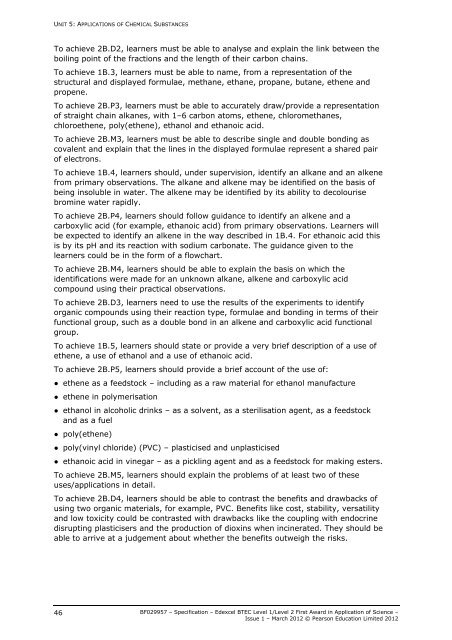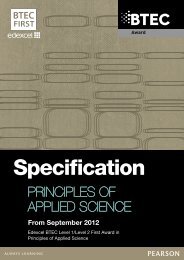BTEC First Award in Application of Science - specification - Edexcel
BTEC First Award in Application of Science - specification - Edexcel
BTEC First Award in Application of Science - specification - Edexcel
Create successful ePaper yourself
Turn your PDF publications into a flip-book with our unique Google optimized e-Paper software.
UNIT 5: APPLICATIONS OF CHEMICAL SUBSTANCES<br />
To achieve 2B.D2, learners must be able to analyse and expla<strong>in</strong> the l<strong>in</strong>k between the<br />
boil<strong>in</strong>g po<strong>in</strong>t <strong>of</strong> the fractions and the length <strong>of</strong> their carbon cha<strong>in</strong>s.<br />
To achieve 1B.3, learners must be able to name, from a representation <strong>of</strong> the<br />
structural and displayed formulae, methane, ethane, propane, butane, ethene and<br />
propene.<br />
To achieve 2B.P3, learners must be able to accurately draw/provide a representation<br />
<strong>of</strong> straight cha<strong>in</strong> alkanes, with 1–6 carbon atoms, ethene, chloromethanes,<br />
chloroethene, poly(ethene), ethanol and ethanoic acid.<br />
To achieve 2B.M3, learners must be able to describe s<strong>in</strong>gle and double bond<strong>in</strong>g as<br />
covalent and expla<strong>in</strong> that the l<strong>in</strong>es <strong>in</strong> the displayed formulae represent a shared pair<br />
<strong>of</strong> electrons.<br />
To achieve 1B.4, learners should, under supervision, identify an alkane and an alkene<br />
from primary observations. The alkane and alkene may be identified on the basis <strong>of</strong><br />
be<strong>in</strong>g <strong>in</strong>soluble <strong>in</strong> water. The alkene may be identified by its ability to decolourise<br />
brom<strong>in</strong>e water rapidly.<br />
To achieve 2B.P4, learners should follow guidance to identify an alkene and a<br />
carboxylic acid (for example, ethanoic acid) from primary observations. Learners will<br />
be expected to identify an alkene <strong>in</strong> the way described <strong>in</strong> 1B.4. For ethanoic acid this<br />
is by its pH and its reaction with sodium carbonate. The guidance given to the<br />
learners could be <strong>in</strong> the form <strong>of</strong> a flowchart.<br />
To achieve 2B.M4, learners should be able to expla<strong>in</strong> the basis on which the<br />
identifications were made for an unknown alkane, alkene and carboxylic acid<br />
compound us<strong>in</strong>g their practical observations.<br />
To achieve 2B.D3, learners need to use the results <strong>of</strong> the experiments to identify<br />
organic compounds us<strong>in</strong>g their reaction type, formulae and bond<strong>in</strong>g <strong>in</strong> terms <strong>of</strong> their<br />
functional group, such as a double bond <strong>in</strong> an alkene and carboxylic acid functional<br />
group.<br />
To achieve 1B.5, learners should state or provide a very brief description <strong>of</strong> a use <strong>of</strong><br />
ethene, a use <strong>of</strong> ethanol and a use <strong>of</strong> ethanoic acid.<br />
To achieve 2B.P5, learners should provide a brief account <strong>of</strong> the use <strong>of</strong>:<br />
● ethene as a feedstock – <strong>in</strong>clud<strong>in</strong>g as a raw material for ethanol manufacture<br />
● ethene <strong>in</strong> polymerisation<br />
● ethanol <strong>in</strong> alcoholic dr<strong>in</strong>ks – as a solvent, as a sterilisation agent, as a feedstock<br />
and as a fuel<br />
● poly(ethene)<br />
● poly(v<strong>in</strong>yl chloride) (PVC) – plasticised and unplasticised<br />
● ethanoic acid <strong>in</strong> v<strong>in</strong>egar – as a pickl<strong>in</strong>g agent and as a feedstock for mak<strong>in</strong>g esters.<br />
To achieve 2B.M5, learners should expla<strong>in</strong> the problems <strong>of</strong> at least two <strong>of</strong> these<br />
uses/applications <strong>in</strong> detail.<br />
To achieve 2B.D4, learners should be able to contrast the benefits and drawbacks <strong>of</strong><br />
us<strong>in</strong>g two organic materials, for example, PVC. Benefits like cost, stability, versatility<br />
and low toxicity could be contrasted with drawbacks like the coupl<strong>in</strong>g with endocr<strong>in</strong>e<br />
disrupt<strong>in</strong>g plasticisers and the production <strong>of</strong> diox<strong>in</strong>s when <strong>in</strong>c<strong>in</strong>erated. They should be<br />
able to arrive at a judgement about whether the benefits outweigh the risks.<br />
46<br />
BF029957 – Specification – <strong>Edexcel</strong> <strong>BTEC</strong> Level 1/Level 2 <strong>First</strong> <strong>Award</strong> <strong>in</strong> <strong>Application</strong> <strong>of</strong> <strong>Science</strong> –<br />
Issue 1 – March 2012 © Pearson Education Limited 2012








